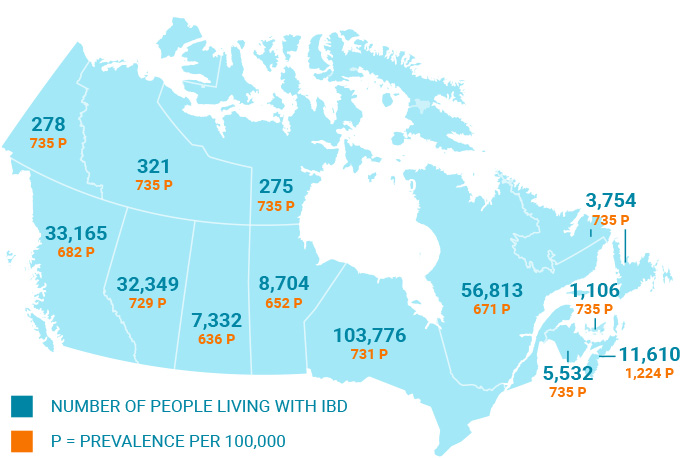November marks the beginning of Crohn’s and Colitis Awareness Month in Canada, and this year, it also coincides with the release of a significant document – the
2018 Impact of Inflammatory Bowel Disease in Canada report.
The report has been prepared by the scientific community to show the effects of Crohn’s disease and ulcerative colitis on individual Canadians, and on the country as a whole. It’s the first comprehensive examination of the diseases and their impact on Canada since 2012.
Incidence and prevalence of IBD in Canada

Key Findings from the 2018 Impact of IBD in Canada report
- 300,000 Canadians are living with inflammatory bowel disease (IBD)
- The direct annual cost of caring for Canadians with IBD is estimated at $1.28 billion
- By 2030, the number of Canadians with IBD is expected to rise to 400,000 (approximately 1% of the population)
- Seniors (aged 65 and over) with Crohn’s or colitis are the fastest growing group of Canadians with IBD, and our healthcare system must be prepared to face this challenge.
- Seniors with Crohn’s or colitis face complications of longer disease duration,and caring for age-related simultaneous conditions such as diabetes and cardiovascular disease.
- Canadians with Crohn’s or colitis in rural areas are less likely to receive gastroenterologist care, which has consequences on long-term outcomes.
- Crohn’s and colitis impact Canadians of all ethnicities and religions, but the rate of new diagnoses is higher among Ashkenazi Jewish and South Asian people.
- There are over 7,000 Canadian children (under age 18) living with Crohn’s or colitis.
- The prevalence of Crohn’s and colitis in Canadian children has risen more than 50% in the last 10 years.
- Children with Crohn’s or colitis have different disease complications, respond differently to treatments, and are at a greater risk of side effects of medication as compared to adults.
You can download our
2018 Impact of Inflammatory Bowel Disease in Canada summary pamphlet here, and the
full report here.
 Facts and faces for Crohn’s and Colitis Awareness Month
Facts and faces for Crohn’s and Colitis Awareness Month
Talk about health statistics often alludes to 'the people behind the numbers.' Well, for this year’s Crohn's and Colitis Awareness Month, we're putting people right alongside the numbers. Throughout November, we'll be sharing an image of a Canadian impacted by Crohn's or colitis, along with a fact from our
2018 Impact of IBD in Canada report on our social media channels (
Facebook,
Twitter,
Instagram, and
LinkedIn).
Have a look at the faces of Crohn's and colitis in Canada, and please share those posts so we can amp up awareness. This month is also the perfect time to tell your stories about living with Crohn's or colitis on social media using the hashtag
#CCawarenessmonth.
Get in-depth understanding about the diseases
Crohn’s and Colitis Awareness Month is the perfect time to gain further knowledge about the diseases, how they can affect the body, and how you can take more control over your health. From emerging treatments to diet to pain management, we have videos on a range of topics ready for viewing on our
newly updated webinars page.
We hope the month ahead is filled with opportunities for you to learn, connect with others, and elevate awareness about Crohn’s disease and ulcerative colitis.